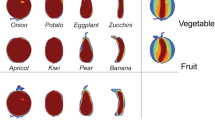Abstract
Dickinson and Szeligo (Can J Exp Psychol 62(4):211–222, 2008) found that processing time for simple visual stimuli was affected by the visual action participants had been instructed to perform on these stimuli (e.g., see, distinguish). It was concluded that these effects reflected the differences in the durations of these various visual actions, and the results were compared to participants’ subjective ratings of word meaning but it was also possible that word characteristics like length might have influenced response times. The present study takes advantage of word length differences between French and English visual action words in order to address this issue. The goals of the present study were to provide evidence that (1) the processing time differences previously found were due to differences in the cognitive actions represented by these words (and not due to characteristics to the words themselves), and (2) that individuals subjectively differentiate visual action words in such a way that allows for predictable differences in behaviour. Participants differentiated 14 French visual action words along two dimensions. Four of these words were then used in the instructions for a size-discrimination task. Processing time depended on the visual action word in the instruction to the task and differed in a predictable manner according to word meaning but not word length.


Similar content being viewed by others
References
Barsalou, L. W. (1999). Perceptual symbol systems. Behavioral and Brain Sciences, 22(4), 577–660.
Baudot, J. (1992). Fréquences d’utilisation des mots en français écrit contemporain. Montreal: Les presses de l’Université de Montréal.
Cacciari, C., & Levorato, M. C. (2000). The semantic structure of vision verbs: A psycholinguistic investigation of Italian. European Journal of Cognitive Psychology, 12(1), 87–106.
Davison, M. L. (1983). Multidimensional scaling. New York: Wiley.
Dickinson, J., & Szeligo, F. (2008). Impact of mental operation instructions. Canadian Journal of Experimental Psychology, 62(4), 211–222.
Hauk, O., & Pulvermuller, F. (2004). Effects of word length and frequency on the human event-related potential. Clinical Neurophysiology, 115, 1090–1103.
Miller, G. A. (1991). Lexical echoes of perceptual structure. In R. Lockhead & J. R. Pomerantz (Eds.), (pp. 249–261). Washington, DC, US: American Psychological Association.
New, B., Pallier, C., Brysbaert, M., & Ferrand, L. (2004). Lexique 2: A new French lexical database. Behavior Research Methods, Instruments & Computers, 36, 516–524.
Pasanen, M. L. (1978). Finnish and English verbs of vision. Further contrastive papers. Jyvaskyla Contrastive Studies, (6), 1–28.
Pulvermüller, F. (2005). Brain mechanisms linking language and action. Nature Reviews Neuroscience. Special Issue: Focus on Pain, 6(7), 576–582.
Pulvermüller, F., Härle, M., & Hummel, F. (2001). Walking or talking?: Behavioral and neurophysiological correlates of action verb processing. Brain and Language, 78(2), 143–168.
Shabanova, T. (2000). Semantic and pragmatic interface in English verbs of vision. http://fccl.ksu.ru/winter.2000/paper5.pdf.
Schneider, W., Eschman, A., & Zuccolotto, A. (2002). E-Prime (Version 1.0). [Computer software and manual]. Pittsburgh, P.A.: Psychology Software Tools Inc.
Schwanenfluegel, P., Fabricius, W. V., Noyes, C. R., & Bigler, K. D. (1994). The organization of mental verbs and folk theories of knowing. Journal of Memory and Language, 33, 376–395.
Thompson, B. (1995). Stepwise regression and stepwise discriminant analysis need not apply here: A guidelines editorial. Educational and Psychological Measurement, 55(4), 525–534.
Author information
Authors and Affiliations
Corresponding author
Rights and permissions
About this article
Cite this article
Dickinson, J., Cirelli, L. & Szeligo, F. Do You ‘See’ What I ‘See’? Differentiation of Visual Action Words. J Psycholinguist Res 43, 1–11 (2014). https://doi.org/10.1007/s10936-012-9235-1
Published:
Issue Date:
DOI: https://doi.org/10.1007/s10936-012-9235-1




